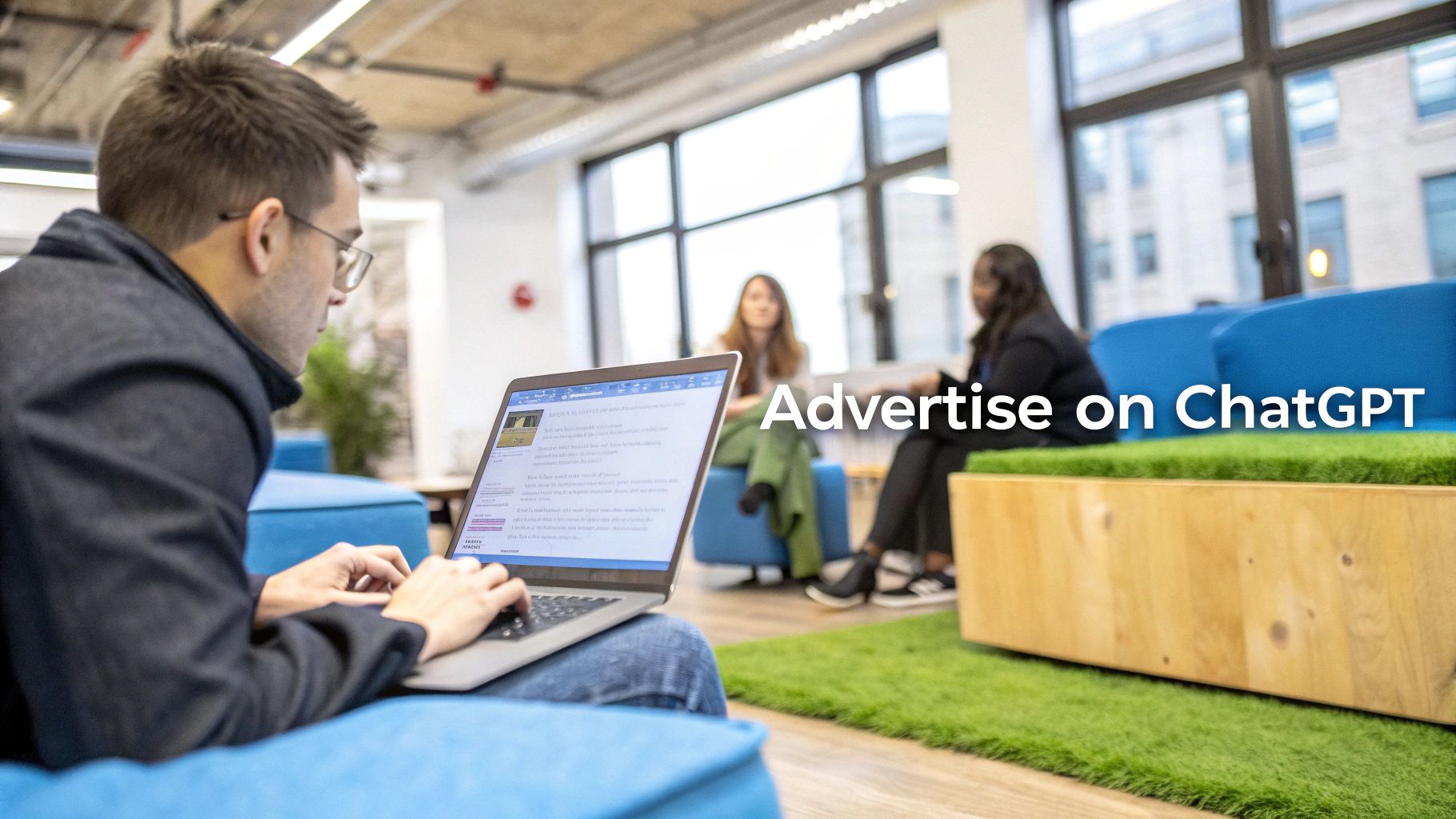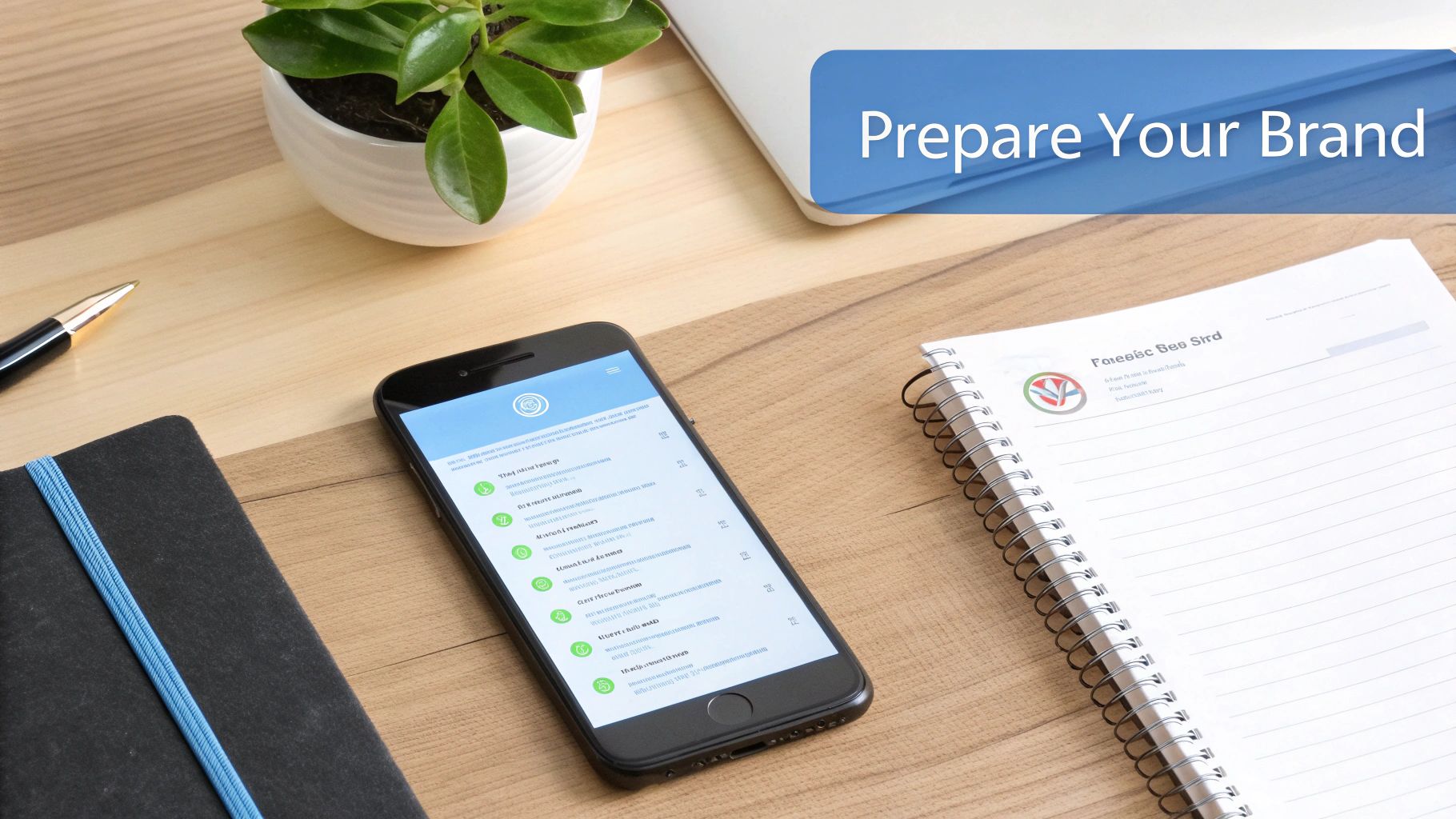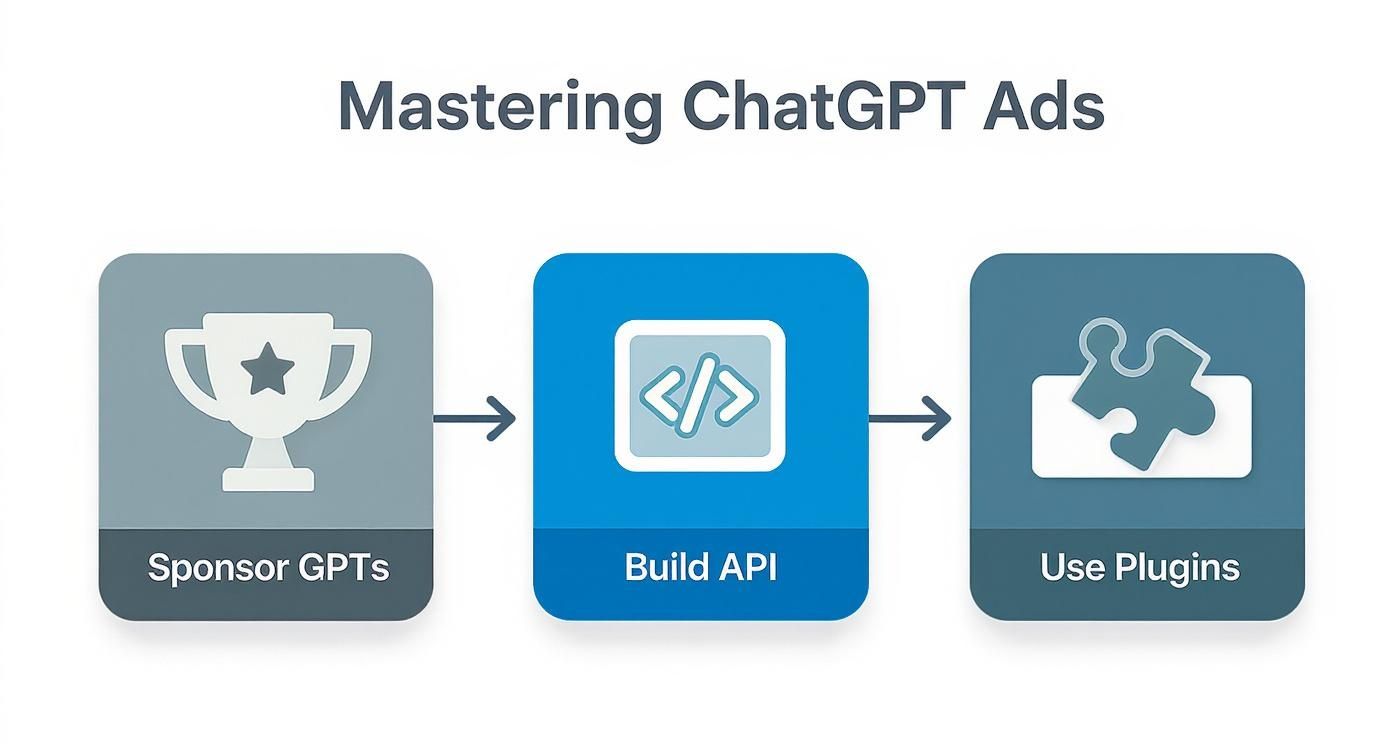How to Advertise on ChatGPT: UK Guide to Boost ROI

How to Advertise on ChatGPT: UK Guide to Boost ROI — Forget everything you think you know about buying banner ads on ChatGPT. You can’t. But you can absolutely advertise on it, and the methods are far more powerful than a simple display ad.
We’re talking about a new frontier in digital marketing, one that’s less about interruption and more about integration. Think sponsoring custom GPTs that solve real user problems or building unique brand experiences through its API. This guide will walk you through exactly how UK businesses can tap into this massive, conversational channel.f
How to Advertise on ChatGPT: The New Frontier of Digital Advertising in the UK

The idea of slapping a traditional ad inside a ChatGPT conversation is a common misconception. The reality is much more interesting and opens up a huge opportunity for brands willing to think differently. Instead of shouting at users, the goal is to become a valuable, helpful part of their interaction with AI.
This shift towards conversational marketing isn’t just some niche trend; it’s the next logical step in digital engagement. UK consumers are weaving AI tools into their daily lives at a staggering pace, creating an entirely new arena for brands to connect with customers. This guide cuts through the hype to give you actionable strategies for this new world.
Understanding the Opportunity
The interest in advertising on ChatGPT has exploded right alongside its user base, reflecting a much bigger trend in UK digital advertising. Investment hit a whopping £38.07 billion in 2025, a 9.4% jump year-on-year, driven heavily by AI-powered platforms.
To put its growth into perspective, ChatGPT became the second most downloaded app in the UK between September and November 2024. That tells you just how embedded it’s becoming in everyday life. For a deeper dive into the numbers, the We Are Social UK Digital 2025 report is well worth a read.
So, how can you actually get your brand in front of these users? Here’s a snapshot of the current methods available right now.
Current Methods to Advertise on ChatGPT in the UK
This table summarises the main advertising and marketing opportunities available through the ChatGPT platform right now. These methods move beyond traditional ads, focusing instead on providing genuine value and utility to the user.
| Method | Description | Best For |
|---|---|---|
| Sponsored GPTs | Creating and promoting a custom version of ChatGPT that solves a specific user problem, with your brand as the sponsor. | Brands looking to build authority and provide a useful tool within a specific niche (e.g., a “Mortgage Calculator GPT” by a bank). |
| API-Driven Experiences | Using the ChatGPT API to build your own branded chatbots or integrate AI into your website, app, or customer service. | Businesses that want to own the user experience completely and integrate AI deeply into their existing digital properties. |
| Plugin Integrations | Developing a plugin that allows ChatGPT to access your brand’s real-time data, like flight prices or product stock. | Companies with dynamic data (travel, e-commerce, real estate) that can provide instant, actionable answers to user queries. |
Each of these approaches requires a shift in thinking. The key is to add value to the user’s conversation, positioning your brand as a helpful partner rather than an intrusive advertiser.
The key is to move away from the mindset of “placing an ad” and towards “providing a service.” When you add value to the user’s conversation, your brand becomes a helpful partner rather than an intrusive advertiser.
Why UK Businesses Must Pay Attention
For UK brands, this is a golden opportunity to get ahead of the curve. While your competitors are still battling it out in crowded social media feeds and search results, you can be building a presence in a less saturated, more engaging environment. The strategies we’ll cover offer a way to create memorable customer journeys that feel personal and genuinely useful.
Of course, mastering these new channels requires a fresh approach to content and engagement. To get your foundations right, check out our ultimate guide for UK brands on mastering ChatGPT for marketing. Throughout this article, we’ll provide the step-by-step instructions you need to launch, manage, and measure your campaigns effectively.
How to Advertise on ChatGPT: Preparing Your Brand for Conversational Advertising

Before you even think about placing an ad on ChatGPT, you need to get your house in order. Just jumping in without a solid game plan is a surefire way to burn through your budget and miss out on what this platform can really do. This isn’t your standard ad channel; it demands a different kind of prep work, focusing on value, authenticity, and being technically ready.
Think of it like this: you wouldn’t launch a massive PPC campaign without first optimising your landing pages. The same logic applies here. Your brand’s voice, your campaign goals, and your tech stack all need to be aligned with the unique, conversational world of ChatGPT.
Define Your Campaign Objectives
First things first, what are you actually trying to achieve? Conversational advertising isn’t a one-size-fits-all solution. Your objectives will shape everything that follows, from the ad format you pick to how you track success. Vague goals like “increase brand awareness” just won’t cut it.
You need to get specific about what a win looks like for your business:
- Lead Generation: Are you hoping to use a custom GPT to qualify leads for a high-ticket service, like financial advice or bespoke software?
- Product Discovery: Could a sponsored GPT act as a personal shopper, helping users find the perfect item from your catalogue, like a “Skincare Routine Finder”?
- Customer Education: Is your goal to answer complex questions about your industry, positioning your brand as the go-to expert?
- Direct Sales: Can you smoothly guide a user through a purchase for a simple ecommerce product?
Picking a clear objective is the most important first step. A campaign built to generate B2B leads will look completely different from one that helps someone choose a new pair of trainers.
Your goal isn’t just to show up in a conversation; it’s to be purposefully present. Every interaction should guide the user towards a specific, valuable outcome—for them and for your business.
Adapt Your Brand Voice for Conversation (How to Advertise on ChatGPT)
That stiff, corporate tone you use elsewhere? It will fall completely flat inside ChatGPT. Users expect a natural, helpful, and almost human-like chat. This is a brilliant opportunity to show off your brand’s personality, but it has to feel real.
If your brand is usually playful and informal, lean into it. If you’re more professional and authoritative, keep that expertise but deliver it in a simpler, more direct way. The key is to be helpful, not robotic. Ditch the marketing jargon and write like you’re talking to one person. To see how this plays out in the real world, it’s worth exploring the dynamics of successful Chat GPT brand partnerships for some valuable insights.
Understand the Technical Prerequisites
Getting your brand ready isn’t just about strategy; there are some practical, technical boxes to tick. Some of the more advanced advertising options, especially those using the API, require a bit of setup before you can get started.
Here are a few key technical checkpoints:
- OpenAI API Key: If your plan involves building a custom chatbot for your own website or app, you’ll need an API key. This is your ticket to integrating ChatGPT’s power into your digital properties.
- Optimised Landing Pages: Any conversation that sends a user to your website must lead to a flawless experience. Make sure your landing pages are mobile-friendly, load fast, and have a clear call-to-action that logically follows the conversation they just had.
- Data and Content Readiness: For a plugin or sponsored GPT to be genuinely useful, it needs access to well-structured information. This could be your entire product catalogue, a knowledge base of helpful articles, or even real-time data like stock levels.
Getting your brand ready for conversational ads is a lot easier when you know the landscape of the best AI marketing tools available to streamline things. These tools can help you manage the data and content that will ultimately fuel your campaigns. Having this infrastructure sorted ensures your AI-powered chats are accurate, helpful, and drive the results you’re after.
How to Advertise on ChatGPT: Getting to Grips with ChatGPT Ad Formats
Forget about buying a standard banner ad here. The opportunities to get your brand in front of people on ChatGPT are far more interesting and, frankly, more effective. The key is to completely shift your mindset from interrupting people to integrating with their conversation. Your goal is to become a genuinely helpful part of their experience, adding real value right when they need it most.
This means you’ve got to let go of familiar ad formats and start thinking conversationally. The smartest strategies right now involve creating or sponsoring experiences that feel less like ads and more like useful tools.
Sponsoring Custom GPTs
One of the most direct routes is sponsoring a custom GPT. These are basically specialised versions of ChatGPT that anyone can build for a specific task – anything from a “London Pub Finder” to a “First-Time Buyer Mortgage Advisor.” Your brand can either build its own from scratch or, even better, partner with an existing, popular one that already has an audience.
Picture this: a UK-based travel company sponsors a “UK Weekend Break Planner” GPT. When someone asks for ideas for a trip to the Cotswolds, the GPT could serve up a brilliant itinerary and then naturally mention, “This itinerary is powered by [Your Brand], which offers curated cottage rentals in the area.” It’s seamless. It’s not intrusive. And it reaches a super-relevant audience at the exact moment they’re making plans.
The real magic here is the context. You aren’t just reaching ‘people interested in travel’; you’re reaching someone actively planning a trip, which makes your brand’s appearance timely and genuinely useful.
Developing Brand-Centric Plugins (How to Advertise on ChatGPT)
Plugins are what give ChatGPT its superpowers, letting it pull in live, third-party information. For any business with dynamic data, this is an absolute game-changer. A UK property portal, for instance, could create a plugin that allows users to ask, “Show me three-bedroom flats to rent in Manchester under £1,500 per month,” and get real-time listings spat back out.
The advertising is subtle, but that’s what makes it so powerful. Your brand becomes the go-to source of information right inside the chat. Every time your plugin delivers a helpful answer, it builds your authority and proves your value. You stop being a static brand and become a dynamic, interactive resource people rely on.
Building Custom API-Driven Experiences
For brands that want total control, the OpenAI API is the ultimate playground. It lets you bake ChatGPT’s conversational power directly into your own website, app, or customer service bot. We’re not just talking about placing an ad here; we’re talking about building a unique, branded conversational experience from the ground up.
A UK fintech firm, for example, could build a “Savings Goal Calculator” on its website. Powered by the API, this tool could have a natural chat with a user about their financial goals, offer personalised advice, and then smoothly guide them towards opening the right savings account. You own the entire journey and can tailor the conversation to perfectly match your brand’s voice and business goals. To see what’s possible, have a look through our guide to compelling Chat GPT ad examples.
Crafting Effective Prompts and Responses (How to Advertise on ChatGPT)
Whichever format you go for, the quality of your conversational content is everything. The number one rule is to provide value first. Any hard-selling language will feel jarringly out of place and users will simply tune it out.
Here are a few pointers for getting the messaging right:
- Be Genuinely Helpful: Your first job is to solve the user’s problem or answer their question. The brand mention should feel like a natural next step, not the main event.
- Keep it Conversational: Ditch the corporate jargon. Write in a clear, simple, and friendly way, just like you were having a real conversation.
- Guide, Don’t Push: Instead of a blunt “Buy Now!” call-to-action, try softer prompts. Something like, “Would you like to see some options available now?” or “You can learn more about this on our website” works much better.
The UK’s rapid adoption of AI tools is creating a massive opportunity. The ChatGPT mobile app has flown past 150 million global downloads, and the UK is a huge part of that. The average UK user session now lasts for 13 minutes – that’s a seriously engaged audience where value-driven content has a real chance to cut through.
To truly get a handle on these unique ad formats, getting a ChatGPT Plus subscription is a great starting point. It gives you a firsthand look at the user experience you’ll be trying to become a part of. By focusing on creating valuable, seamless interactions, you can tap into a highly engaged audience and build much stronger connections.
How to Advertise on ChatGPT: Targeting Audiences and Launching Your Campaign
Right, you’ve got your creative ideas lined up. Now for the practical part: getting your campaign live and in front of the right people. Advertising on a platform like ChatGPT requires a bit of a mental shift. You’re not just throwing ads at demographics anymore. Forget targeting based on age or location; this is all about user intent.
Success here is about meeting people in the middle of a conversation, right when they need you. You’re no longer targeting a broad category like “males aged 25-34 in London.” Instead, you’re targeting a specific moment of need. Picture it: someone is chatting with a “UK University Course Finder” GPT, or another is asking about sustainable packaging options. That’s your cue. This intent-driven approach means you connect with a hyper-relevant, engaged audience at the perfect time.
Pinpointing Your Audience Through Intent
Targeting on ChatGPT is less about fiddling with settings and more about smart placement. Your main tools for reaching people are the context of their conversation and the specific custom GPTs they’re using. Think of it as pull marketing, not push.
You can really zero in on your ideal audience by focusing on two key areas:
- Topical Relevance: Get to know the conversations and questions that signal a user is in your market. Someone asking for vegan recipes? A perfect match for a plant-based food brand. The trick is to map out the problems your product solves and then find the conversations where those problems are being aired.
- GPT Sponsorship: This is your most direct route. By creating or sponsoring a custom GPT that serves a specific niche, you’re guaranteeing every user is highly qualified. For example, sponsoring a “DIY Home Renovation Cost Calculator” ensures you’re only talking to homeowners who are actively planning a project.
This infographic breaks down the core paths to getting your advertising right on ChatGPT, from sponsoring GPTs to building with the API.

As you can see, each method—sponsoring, building, or integrating—is about providing genuine utility, not just interrupting a user’s flow.
Setting Budgets and Understanding Bidding (How to Advertise on ChatGPT)
Since there’s no traditional ad auction here, budgeting and bidding work a bit differently. For experiences driven by the API, your cost is tied directly to usage – you pay for the processing power your tool consumes. For sponsorships, the cost will likely be a flat fee negotiated with the GPT creator, much like you would with an influencer.
When you’re figuring out your budget, it’s always smart to start small with a pilot project. Set aside a modest amount, maybe £1,000 to £3,000, to test a single idea. This lets you get some initial data on engagement and prove the concept before you dive in with a bigger investment. It’s a great way to minimise risk while gathering the real-world data you’ll need to forecast your potential return.
Think of your initial budget as an investment in learning. The goal of your first campaign isn’t necessarily a massive ROI; it’s to gather the crucial data that will make all your future campaigns profitable.
Implementing Robust Tracking and Measurement
Proving your campaign worked is everything, but you can’t just look at standard click-through rates. Measuring success in a conversational setting is more nuanced; it’s about tracking how your brand actually influences the user’s journey.
Your best friend here is the humble UTM parameter. Any link you share within a conversation, whether from your sponsored GPT, a plugin, or an API chatbot, absolutely must be tagged. This is how you’ll follow users who land on your site and see what they do next in your existing analytics platform, like Google Analytics.
Here’s a basic framework for what you should be tracking:
- Interaction Rate: How many people are actually engaging with your GPT or plugin?
- Conversation Depth: How many messages are flying back and forth? Deeper conversations are a strong signal of high engagement.
- Link Clicks (with UTMs): The number of users who click through to your website from the chat.
- On-site Conversions: Of those who clicked, how many actually did what you wanted them to do (like filling out a form or buying something)?
- Sentiment Analysis: If you can, analyse the conversations to get a feel for whether user sentiment towards your brand is positive.
By pulling these metrics together, you can build a really clear picture of your campaign’s performance. You’ll be able to show not just how many people you reached, but how deeply you engaged them and what real business value that engagement created. This helps shift the conversation with stakeholders from vague impressions to tangible impact.
How to Advertise on ChatGPT: Measuring Success and Optimising Your Campaigns

Launching your campaign is just the beginning. To truly succeed when you advertise on ChatGPT, you need a smart approach to measurement and a relentless focus on optimisation. After all, great advertising is built on data, and in this new conversational world, the metrics that actually matter are quite different from your typical PPC campaign.
Forget fixating on old-school clicks and impressions. Success here is all about the quality of the interaction. We’re talking about engagement rates, how deep a conversation goes, and whether the user actually got what they came for. This really requires a new way of thinking about performance.
Beyond Clicks: Key Metrics For Conversational Ads
To get a true picture of your campaign’s health, you need to track a blend of conversational and traditional KPIs. This holistic view shows you not just what’s happening inside the chat, but how it’s actually impacting your bottom line.
Here are the essential metrics we monitor:
- Engagement Rate: This is the percentage of users who actively interact with your sponsored GPT or plugin. It’s your top-level indicator of whether you’re grabbing attention.
- Conversation Depth: Are users just sending one message and then bouncing, or are they having a meaningful, multi-turn dialogue? Deeper conversations signal much higher user investment and interest.
- Task Completion Rate: Did the user achieve their goal? Whether that was finding a product, getting an answer, or receiving a quote, this is a direct measure of your tool’s real-world utility.
- Sentiment Analysis: Looking at the tone of conversations helps you understand how users feel about the interaction. Positive sentiment is a strong sign your brand voice and helpful approach are hitting the mark.
- Click-Through Rate (CTR) to Site: For any links you share in the chat, what percentage of users are clicking through? This is the crucial bridge connecting the conversational experience to your website traffic.
These metrics tell a much richer story than simple clicks ever could. They tell you if you’re being genuinely helpful, which is the ultimate goal. For more on this, you might be interested in our guide on how to measure advertising effectiveness with a modern mindset.
To properly measure success, you need to look at both traditional PPC metrics and new conversational ones. Here’s a breakdown of what to watch.
Key Metrics for Measuring ChatGPT Ad Performance (How to Advertise on ChatGPT)
| Metric | What It Measures | Why It’s Important for ChatGPT |
|---|---|---|
| Engagement Rate | The percentage of users who start a meaningful interaction with your ad. | This is your first signal that your prompt or GPT is compelling enough to draw users in. |
| Conversation Depth | The average number of back-and-forth messages per user session. | Deeper conversations mean higher interest and a more valuable interaction for the user. |
| Task Completion Rate | Whether the user successfully finished their intended action (e.g., got an answer, found a product). | This is the ultimate measure of your ad’s utility and helpfulness. |
| Sentiment Analysis | The emotional tone (positive, negative, neutral) of the user’s messages. | Helps you understand the user experience and whether your brand voice is resonating. |
| Click-Through Rate (CTR) | The percentage of users who click a link you provide in the conversation. | Connects the conversational ad to your website, driving tangible traffic and leads. |
| Cost Per Engaged User | Your total ad spend divided by the number of users who meaningfully engaged. | A more relevant cost metric than Cost Per Click (CPC) in a conversational context. |
By tracking these KPIs, you get a much clearer picture of what’s truly driving value, allowing you to optimise for genuine user satisfaction, not just vanity metrics.
A Practical Framework For Testing and Optimisation
Continuous improvement is non-negotiable. The best way to refine your campaigns is through structured testing, and A/B testing is your most powerful tool here. It lets you compare different elements head-to-head to see what performs best.
Don’t just test the big ideas; sometimes the smallest tweaks can make a massive difference.
- Test different opening prompts: Does a direct question or a friendly greeting get more engagement?
- Vary your calls-to-action: Compare “Learn more on our site” with “Would you like to see some options?” to see which drives more clicks.
- Experiment with response length: Are shorter, punchier answers more effective than detailed explanations?
By isolating one variable at a time, you can gather clean data on what truly moves the needle. This iterative process turns guesswork into a data-driven strategy for boosting performance.
Optimisation in conversational advertising is less about finding the perfect keyword and more about refining the perfect conversation. Each test brings you closer to an experience that feels natural, helpful, and effective.
Uncovering Insights From Conversation Logs
Conversation logs are a goldmine of customer intelligence—provided you handle them with absolute respect for user privacy, of course. By analysing anonymised transcripts, you can uncover common user pain points, recurring questions, and unmet needs.
This analysis can spark ideas for new features, fresh website content, or even entirely new custom GPTs. For instance, if dozens of users are asking your “Mortgage Calculator” GPT about stamp duty, perhaps that’s a feature you need to build in or a blog post you need to write.
This feedback loop—where real user conversations directly inform your marketing strategy—is incredibly powerful. The adoption of AI for these kinds of workflows is already showing huge returns. For UK businesses, this integration has led to productivity gains of 30-45% and annual savings topping £75,000. Key sectors benefiting include tech, education, and business services. You can discover more about these findings on the impact of ChatGPT in business. This data highlights how analysing performance isn’t just about tweaking ads; it’s about fundamentally improving your entire business.
Common Questions About Advertising on ChatGPT
Stepping into a new advertising channel always throws up a few questions. That’s especially true for a platform like ChatGPT, where the playbook is still being written and it doesn’t operate like your typical paid media platform. We’ve rounded up some of the most common queries we get from UK businesses, giving you the straight answers you need to move forward.
Can I Actually Run Banner Ads on ChatGPT in the UK?
This is the big one we hear all the time, and the short answer is no. OpenAI doesn’t currently sell traditional banner or display ad space inside the main ChatGPT interface. You can’t just buy a slot like you would on a news website or social media feed.
The whole approach is built on a completely different philosophy. Instead of interrupting the user with a flashy ad, the idea is to integrate your brand into their conversation in a way that’s genuinely helpful. That’s why the real opportunities lie in value-driven tactics, like sponsoring a popular custom GPT or building a useful tool with the API. It’s about being part of the solution, not the interruption, which builds far more trust than a simple display ad ever could.
What Kind of Budget Does a Small UK Business Need to Start?
Because there isn’t a one-size-fits-all ad platform, your starting budget really depends on which route you take. The costs can vary massively.
- Sponsoring a GPT: This usually involves a direct deal with the creator of a popular custom GPT. Think of it like an influencer marketing partnership, where the price could be a flat fee negotiated upfront.
- Building an API-driven experience: If you’re creating a custom chatbot for your website, your main costs are tied directly to API usage. You pay based on the volume of data processed, so a bot that gets tons of traffic will cost more than one used only occasionally.
For a small UK business looking to dip its toes in the water, we suggest setting aside a pilot project budget of around £1,000 to £3,000. This is a realistic amount to build and test a single use case, get some crucial performance data back, and prove the concept works before you think about a bigger investment.
Think of your initial spend as a data-gathering exercise. The goal isn’t immediate profit but to validate your idea and collect the insights needed to scale effectively.
How Do I Keep My Campaigns Compliant with UK GDPR?
Compliance isn’t just a box-ticking exercise; it’s non-negotiable, especially with regulations as strict as UK GDPR. When you use the OpenAI API to build a tool that your customers interact with, you are the data controller. That puts all the responsibility squarely on your shoulders.
Here are the critical things you absolutely must do to stay compliant:
- Be Transparent: Your privacy policy needs a clear update. It must explain that you use AI models to process conversations and specify what data is involved.
- Avoid Personal Data Collection: Don’t ask for or store sensitive personal information within the chat unless you have explicit, unambiguous consent for a very specific purpose.
- Follow Platform Policies: If you sponsor a GPT or build a plugin, you have to stick rigidly to OpenAI’s own usage policies and developer agreements.
Ultimately, your safest move is to talk to a legal expert who specialises in UK data protection law. They can review exactly what you’re planning to do and give it the all-clear before you go live. It’s the best way to protect both your customers and your business from some very significant risks. Advertising on ChatGPT is a unique way to connect with people, but it has to be done responsibly.
Ready to explore how your brand can effectively work with PPC Geeks and connect with a highly engaged audience? Our team of UK-based experts can help you navigate this new channel and build a data-driven strategy that delivers real results. Get in touch with us today for a free audit and consultation.
Author
Search Blog
Free PPC Audit
Subscribe to our Newsletter
The Voices of Our Success: Your Words, Our Pride
Don't just take our word for it. With over 100+ five-star reviews, we let our work-and our satisfied clients-speak for us.
"We have been working with PPC Geeks for around 6 months and have found Mark and the team to be very impressive. Having worked with a few companies in this and similar sectors, I rate PPC Geeks as the strongest I have come across. They have taken time to understand our business, our market and competitors and supported us to devise a strategy to generate business. I value the expertise Mark and his team provide and trust them to make the best recommendations for the long-term."
~ Just Go, Alasdair Anderson
